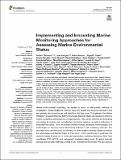Por favor, use este identificador para citar o enlazar a este item:
http://hdl.handle.net/10261/142973COMPARTIR / EXPORTAR:
 SHARE SHARE
 CORE
BASE CORE
BASE
|
|
| Visualizar otros formatos: MARC | Dublin Core | RDF | ORE | MODS | METS | DIDL | DATACITE | |

| Título: | Implementing and Innovating Marine Monitoring Approaches for Assessing Marine Environmental Status |
Autor: | Danovaro, Roberto; Garcés, Esther CSIC ORCID CVN ; Gasol, Josep M. CSIC ORCID ; Ferrera, Isabel CSIC ORCID; Reñé, Albert CSIC ORCID ; Borja, Ángel | Palabras clave: | Marine monitoring Marine Strategy Framework Directive Marine biodiversity Molecular approaches In situ monitoring |
Fecha de publicación: | nov-2016 | Editor: | Frontiers Media | Citación: | Frontiers in Marine Science 3: 213 (2016) | Resumen: | Marine environmental monitoring has tended to focus on site-specific methods of investigation. These traditional methods have low spatial and temporal resolution and are relatively labor intensive per unit area/time that they cover. To implement the Marine Strategy Framework Directive (MSFD), European Member States are required to improve marine monitoring and design monitoring networks. This can be achieved by developing and testing innovative and cost-effective monitoring systems, as well as indicators of environmental status. Here, we present several recently developed methodologies and technologies to improve marine biodiversity indicators and monitoring methods. The innovative tools are discussed concerning the technologies presently utilized as well as the advantages and disadvantages of their use in routine monitoring. In particular, the present analysis focuses on: (i) molecular approaches, including microarray, Real Time quantitative PCR (qPCR), and metagenetic (metabarcoding) tools; (ii) optical (remote) sensing and acoustic methods; and (iii) in situ monitoring instruments. We also discuss their applications in marine monitoring within the MSFD through the analysis of case studies in order to evaluate their potential utilization in future routine marine monitoring. We show that these recently-developed technologies can present clear advantages in accuracy, efficiency and cost | Descripción: | Danovaro, Roberto ... et al.-- 25 pages, 9 figures, 2 tables | Versión del editor: | https://dx.doi.org/10.3389/fmars.2016.00213 | URI: | http://hdl.handle.net/10261/142973 | DOI: | 10.3389/fmars.2016.00213 | Identificadores: | doi: 10.3389/fmars.2016.00213 e-issn: 2296-7745 |
| Aparece en las colecciones: | (ICM) Artículos |
Ficheros en este ítem:
| Fichero | Descripción | Tamaño | Formato | |
|---|---|---|---|---|
| Danovaro_et_al_2016.pdf | 977,8 kB | Adobe PDF |  Visualizar/Abrir |
CORE Recommender
SCOPUSTM
Citations
147
checked on 20-abr-2024
WEB OF SCIENCETM
Citations
137
checked on 29-feb-2024
Page view(s)
381
checked on 23-abr-2024
Download(s)
389
checked on 23-abr-2024
Google ScholarTM
Check
Altmetric
Altmetric
Este item está licenciado bajo una Licencia Creative Commons

